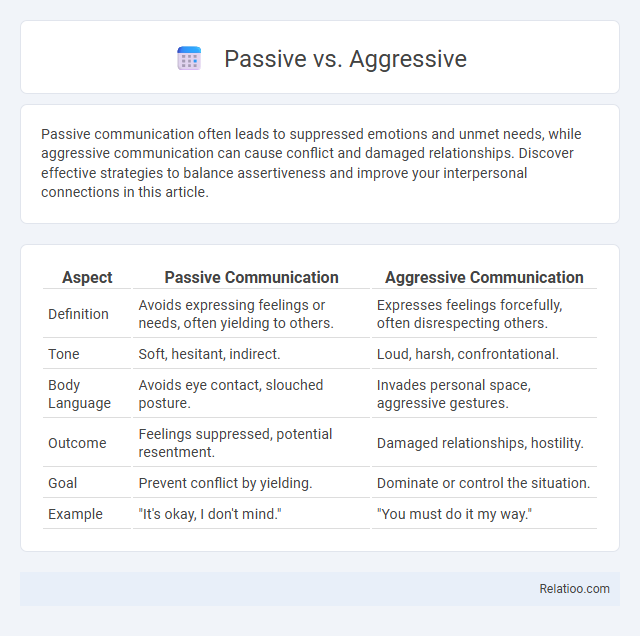Passive communication often leads to suppressed emotions and unmet needs, while aggressive communication can cause conflict and damaged relationships. Discover effective strategies to balance assertiveness and improve your interpersonal connections in this article.
Table of Comparison
| Aspect | Passive Communication | Aggressive Communication |
|---|---|---|
| Definition | Avoids expressing feelings or needs, often yielding to others. | Expresses feelings forcefully, often disrespecting others. |
| Tone | Soft, hesitant, indirect. | Loud, harsh, confrontational. |
| Body Language | Avoids eye contact, slouched posture. | Invades personal space, aggressive gestures. |
| Outcome | Feelings suppressed, potential resentment. | Damaged relationships, hostility. |
| Goal | Prevent conflict by yielding. | Dominate or control the situation. |
| Example | "It's okay, I don't mind." | "You must do it my way." |
Understanding Passive and Aggressive Behaviors
Passive behavior is characterized by avoiding confrontation and suppressing personal needs, often leading to feelings of resentment or helplessness. Aggressive behavior involves expressing needs or desires forcefully and often disrespectfully, which can cause conflict and damage relationships. Understanding these behaviors helps in recognizing unhealthy communication patterns and promotes the development of assertive skills for balanced interactions.
Key Characteristics of Passive Communication
Passive communication is characterized by avoidance of expressing opinions, needs, or feelings, often to evade conflict or gain approval. Individuals using passive communication may exhibit poor eye contact, soft speech, and body language that signals submission or insecurity. This style often leads to misunderstandings and resentment as the communicator's true thoughts remain unspoken.
Key Traits of Aggressive Communication
Aggressive communication is characterized by a direct and forceful expression of needs or opinions, often disregarding others' feelings or rights. Key traits include domination, criticism, blame, and an intimidating tone intended to control or overpower the listener. This style frequently leads to conflict, resentment, and damaged relationships due to its confrontational and uncompromising nature.
Comparing Outcomes: Passive vs Aggressive Responses
Passive responses often result in unresolved conflicts and suppressed emotions, leading to long-term dissatisfaction and decreased self-esteem. Aggressive responses may achieve immediate goals but tend to escalate conflicts, damage relationships, and foster resentment. Comparing outcomes, passive strategies typically avoid confrontation but sacrifice personal needs, while aggressive behaviors risk relational harm despite asserting control.
Psychological Roots Behind Each Behavior
Passive behavior often stems from fear of confrontation or low self-esteem, causing individuals to avoid expressing their true feelings. Aggressive behavior is typically rooted in a need for control, dominance, or unresolved anger, which drives people to assert themselves forcefully. Your understanding of passive-aggressive behavior involves recognizing the underlying frustration and indirect communication that mask true emotions and intentions.
Effects on Relationships and Social Interactions
Passive communication often leads to misunderstandings and resentment because Your feelings and needs are suppressed, causing frustration and distance in relationships. Aggressive behavior can create fear, hostility, and conflict, damaging trust and damaging social bonds. Passive-aggressive actions confuse and frustrate others, eroding communication and causing tension and mistrust in social interactions.
Workplace Dynamics: Passive vs Aggressive Employees
Passive employees often avoid confrontation and suppress their opinions, leading to unresolved issues and decreased team productivity in the workplace. Aggressive employees, on the other hand, tend to dominate conversations and impose their views, which can create a hostile work environment and increase conflict. Your ability to recognize and manage these contrasting behaviors is essential for fostering effective communication and maintaining a balanced team dynamic.
Impact on Mental Health and Well-being
Passive behavior often leads to internalized stress and anxiety due to suppressed emotions, negatively impacting your mental health. Aggressive behavior can cause interpersonal conflicts and increased stress levels, which deteriorate overall well-being. Passive-aggressive tendencies create confusion and emotional distress both for you and others, fostering a toxic environment that hampers emotional stability.
Navigating Conflict: When to Avoid Each Style
Navigating conflict effectively requires recognizing when to avoid passive, aggressive, and passive-aggressive behaviors to maintain healthy communication. Passive responses often lead to unmet needs and resentment, while aggressive tactics can escalate tensions and damage relationships. You should strive for assertive communication to express your needs clearly without provoking hostility or fostering hidden bitterness.
Moving Towards Assertiveness: A Balanced Approach
Passive behavior often involves avoiding confrontation and suppressing one's needs, while aggressive behavior disregards others' feelings by imposing demands or criticisms. Passive-aggressive actions mask underlying anger through indirect expressions like sarcasm or procrastination, creating confusion and resentment. Moving towards assertiveness requires embracing clear, respectful communication that honors both personal rights and others' perspectives, fostering healthier and more balanced interactions.

Infographic: Passive vs Aggressive
 relatioo.com
relatioo.com